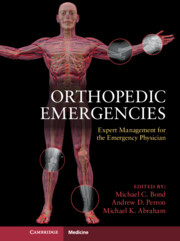Book contents
- Orthopedic Emergencies: Expert Management for the Emergency Physician
- Orthopedic Emergencies: Expert Management for the Emergency Physician
- Copyright page
- Contents
- Contributors
- Preface
- Chapter 1 Hand and wrist emergencies
- Chapter 2 Shoulder and elbow emergencies
- Chapter 3 Pelvic emergencies
- Chapter 4 Knee and leg emergencies
- Chapter 5 Foot and ankle emergencies
- Chapter 6 Spine emergencies
- Chapter 7 Pediatric orthopedic emergencies
- Chapter 8 Orthopedic infections and other complications
- Chapter 9 Procedures for orthopedic emergencies
- Chapter 10 Immobilization and splinting
- Index
Chapter 2 - Shoulder and elbow emergencies
Published online by Cambridge University Press: 05 November 2013
- Orthopedic Emergencies: Expert Management for the Emergency Physician
- Orthopedic Emergencies: Expert Management for the Emergency Physician
- Copyright page
- Contents
- Contributors
- Preface
- Chapter 1 Hand and wrist emergencies
- Chapter 2 Shoulder and elbow emergencies
- Chapter 3 Pelvic emergencies
- Chapter 4 Knee and leg emergencies
- Chapter 5 Foot and ankle emergencies
- Chapter 6 Spine emergencies
- Chapter 7 Pediatric orthopedic emergencies
- Chapter 8 Orthopedic infections and other complications
- Chapter 9 Procedures for orthopedic emergencies
- Chapter 10 Immobilization and splinting
- Index
Summary
- Type
- Chapter
- Information
- Orthopedic EmergenciesExpert Management for the Emergency Physician, pp. 44 - 80Publisher: Cambridge University PressPrint publication year: 2013

